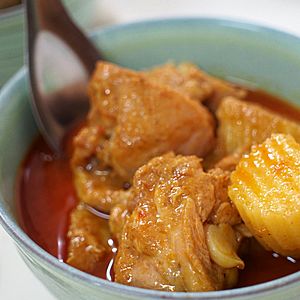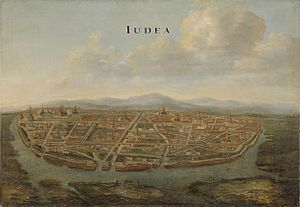Massaman curry facts for kids

Chicken massaman with potato
|
|
| Type | Curry |
|---|---|
| Place of origin | Thailand |
| Main ingredients | Meat (beef, duck, or chicken) or tofu, coconut milk, onion, peanuts or cashews, potatoes, bay leaves, cardamom pods, cinnamon, star anise, palm sugar, fish sauce, chili and tamarind juice |
| Similar dishes | Saraman curry |
Massaman curry (Thai: แกงมัสมั่น, RTGS: kaeng matsaman) is a tasty and mildly spicy Thai curry. It's a special mix of flavors, bringing together ingredients from places like Persia, India, and the Malay Archipelago. These include spices like cardamom, cinnamon, cloves, star anise, and cumin. It also uses ingredients common in Thai cooking, such as chili peppers, coriander, lemongrass, and garlic.
The main parts of Massaman curry are usually chicken or other meats, potatoes, onions, and peanuts. It gets its rich, creamy texture from coconut milk, which is a key ingredient in many Thai curries. In 2011 and again in 2018, CNNGo called Massaman curry the number one most delicious food in the world!
What's in Massaman Curry?
Because of its Muslim origins, Massaman curry is most often made with chicken. But you can also find versions with duck, beef, venison, mutton, or goat. Some people even make it with pork, but this version is not eaten by Thai Muslims because pork is forbidden in their religion.
Vegetarians and vegans have also created their own versions. They might use tofu instead of meat and skip ingredients like shrimp paste or fish sauce.
Special Spices
The Muslim roots of this dish are clear in the many spices used in its curry paste. These spices are not usually found in other Thai curries. Spices like cardamom, cinnamon, cloves, star anise, cumin, bay leaves, and nutmeg were brought to Thailand a long time ago. Traders from the Middle East, Indian subcontinent, and the Malay Archipelago introduced them. Later, European traders also brought these spices.
These special foreign spices are mixed with local Thai ingredients. These include dried chili peppers, coriander seeds, lemongrass, galangal, white pepper, shrimp paste, shallots, and garlic. All these ingredients are blended to make the unique Massaman curry paste.
How It's Made
To cook Massaman curry, the curry paste is first fried with coconut cream. This helps to bring out its flavors. Then, meat, potatoes, onions, fish sauce (or salt), tamarind paste, sugar, more coconut milk, and peanuts are added.
Massaman curry is usually eaten with rice as part of a meal with other dishes. Sometimes, people even add oranges, orange juice, or pineapple juice to the curry for extra flavor!
History of Massaman Curry
The name massaman comes from an old Persian word, mosalman, which means "Muslim." This is why people in the mid-1800s sometimes called it "Mussulman curry."
Experts like Thai journalist Santi Sawetwimon and food expert David Thompson believe the dish started in the 17th century. It was created in central Thailand at the royal court of Ayutthaya. This was a very diverse place, and the curry was likely influenced by a Persian merchant named Sheik Ahmad Qomi. Many people also think that Massaman is a southern Thai dish, influenced by Malay and Indian cuisine.

Massaman curry is even mentioned in an old poem from the late 1700s called Kap He Chom Khrueang Khao Wan. This poem is thought to be written by Prince Itsarasunthon, who later became King Rama II of Thailand. The poem praises the curry and describes its wonderful smell and strong taste, saying it makes anyone who eats it long for the person who made it.
The first known recipe for Massaman curry was written in 1889 by Lady Plean Passakornrawong. It was called "Chicken Massaman curry with bitter orange juice."
See also
 In Spanish: Curry Massaman para niños
In Spanish: Curry Massaman para niños



